Assessment Guide

What have we got?
First we have to find out what we are dealing with.
That means finding the Reference Number inside the case-back, and the eight digit serial number in the movement.
If you are new to Speedmasters – especially if you are new to vintage watches, do not skip this page. It is relevant for each of the watches we look at and should be read in conjunction with the detailed reference pages.
Most sellers will have opened the watch and photographed the inside, but if you buy it you need to check the watch you have received is the watch you agreed to buy. We need to open the watch and establish:
- The calibre, 861 or 321
- The movement number. Eight digits.
- The case reference, from inside the case back.
So the watch needs to be opened, using the proper tool. Since this site was first written, Mr Pahawi has come up with this most excellent tool, that you can order by contacting him direct. See the page here or link at the sidebar.
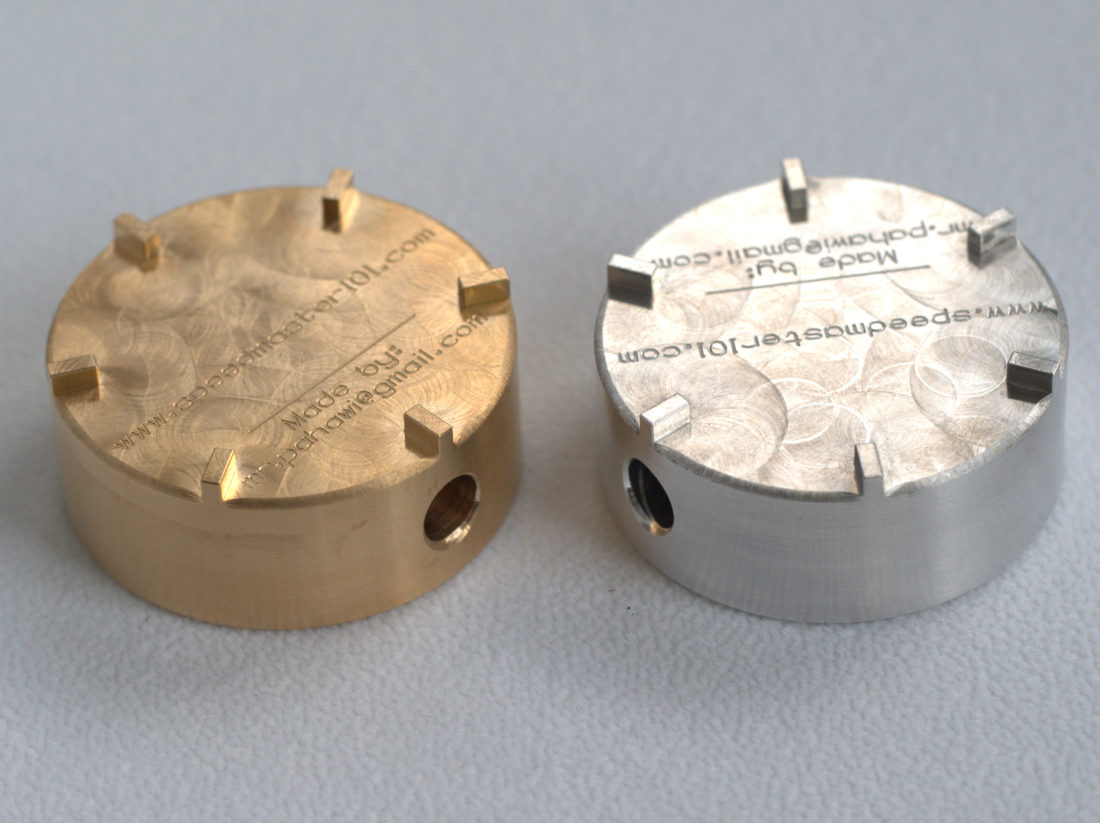
Here shown are the Pahawi openers.
These were purpose built for Speedmasters, although the size fits several other Omegas too. They are simple, very well made and since I got it, I have not used anything else.
If you are going to open your speedmaster, even once, it is worth having.
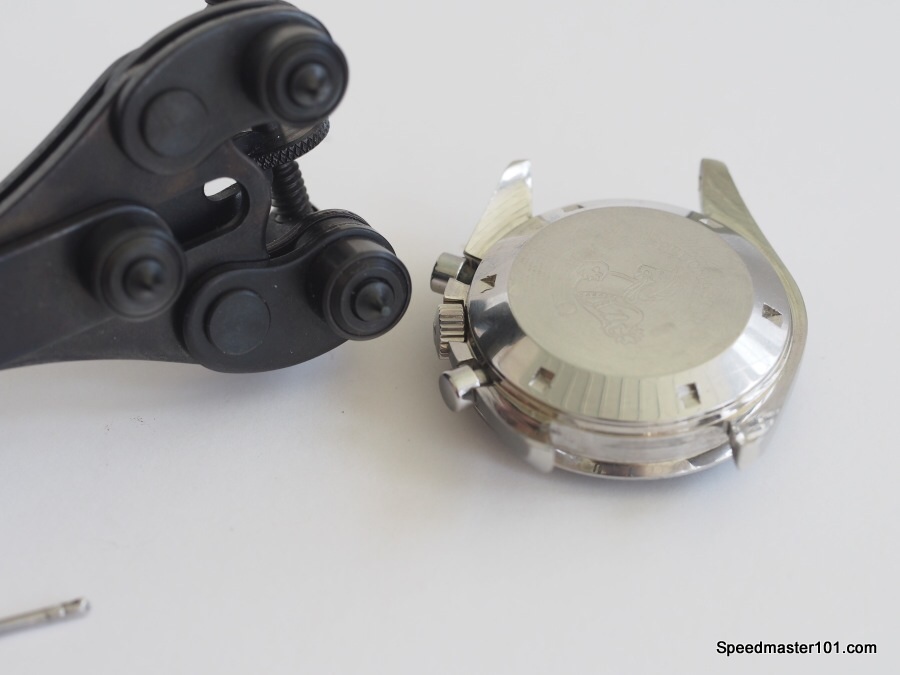
This is the three prong opener that I used before the Pahawi openers were produced. They are easily available from amazon and if you need to get an opener quickly these might work.
Be sure to adjust them carefully to the back slots and keep pressure on the back to prevent slipping.
I can tell you I have slipped using these. Dont rush. Be very sure of the fit/grip before you turn.
Better still wait until you get the Pahawi opener.

With the back removed, this will reveal the dust cover. This needs to be removed with fine tweezers or a blade. DO NOT cover it in fingerprints – the oils from your fingertips will stay inside the case once you seal it back up and contribute to decay.
Sometimes the cover will fall off, when you tip the watch. Other times the fit is tight and will need a fine blade or tips of tweezers to pop it off. I put the blade, or tweezers tips, near the stem, so I do not accidentally lift the movement.
Calibres
The movement should be an Omega signed, copper coloured 321 or 861 calibre, and the serial marked with eight digits.
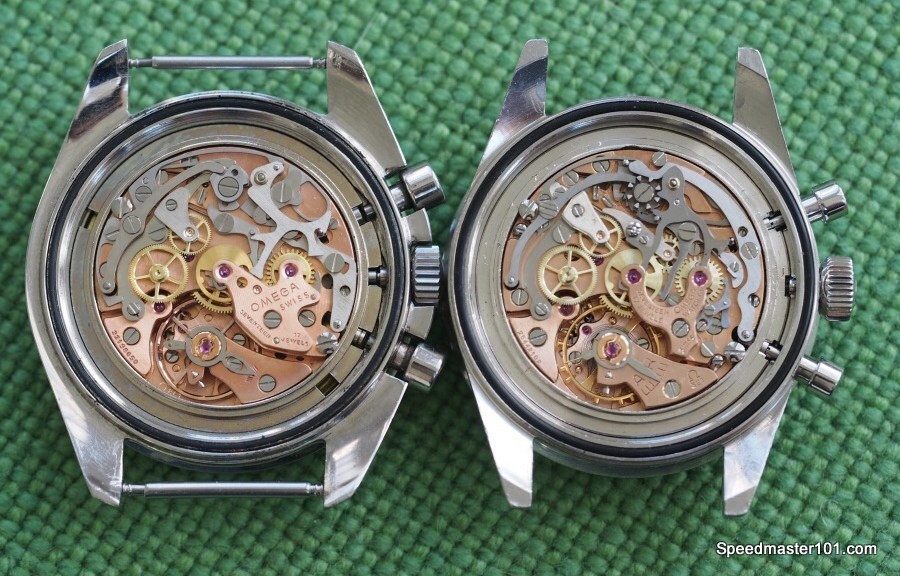
Lemania made similar movements for other brands, (and themselves) and the parts from these are a different colour, but interchangeable. In fact entire Lemaina movements can be transplanted into a Speedmaster. I know this for a fact as I once bought one at the Pasadena watch show – luckily I returned it. This is why it is so important to see inside, even if you think you don’t know what you are doing, you can still check the movement is copper coloured, signed, and numbered.
Armed with the calibre, and the case reference we can check the movement serial falls within accepted ranges for the reference.
Speedmaster year dating has been transformed by the database query site :
https://www.ilovemyspeedmaster.com/productiondateprediction/
This will give you a date estimate compared to known examples backed up by extracts of the archives of known watches. What this will not do is confirm that the movement you have is actually a speedmaster movement. Only an extract of the archives can do that, here:
https://www.omegawatches.com/customer-service/extract-of-the-archives
Once you have the extract you can be sure the movement number matches the case reference. Sometimes the museum will say they lack information and keep your money – in that instance I think the movement is in the wrong case. If they refund you then I think it is because they really do not have the records, and the watch may indeed be original and correct.
Case Types
Straight Lugs:
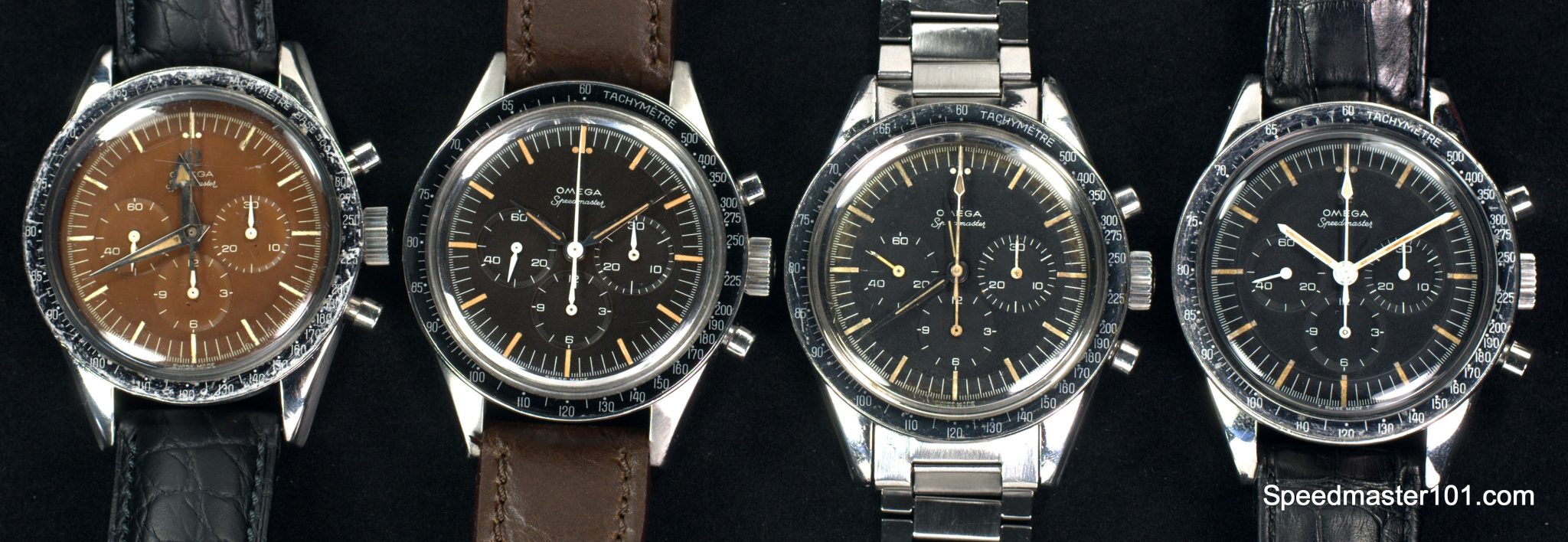
Above are four examples of straight lugs, 2915, 2998, 105.002 and 105.003. Note the pushers and crown are exposed. The distance between the lugs (Strap width) is 19mm
Here are four asymmetric cases:
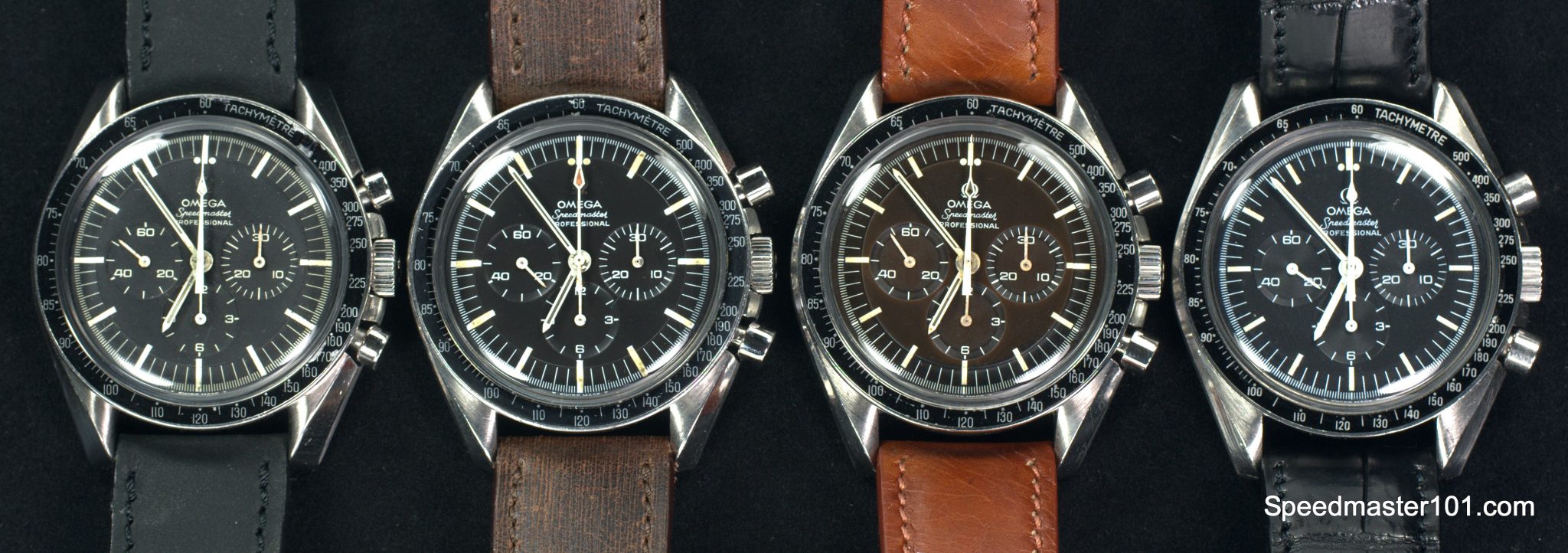
Above are four examples of Asymmetric lugs, 105012, 145.012, 145.022 and 145.022. Note the pushers and crown are protected by the case. The distance between the lugs (Strap width) is 20mm
| Straight Lug Case | Asymmetric Case |
| 2915 | 105.012 |
| 2998 | 145.012 |
| 105.002 | 145.022 |
| 105.003 | |
| 145.003 |

- The asymmetric case came in both calibres,
- The straight lug only carried a 321.
- The 861 was only used in the asymmetric case.
- The full list of references and sub references is here.
General Principles
So now you should know:
- The Case Reference
- The Calibre
- The Movement Serial
Now you can check the movement number fits the observed ranges for the reference. Then using the price chart get an idea of what the price might be. For every flaw or incorrect part, the value is reduced. Remember the price chart needs to be used with caution.
When I first see a watch, I ask myself if I like the look of it. Does it give me pleasure to see it? This for example does:

Here is another lovely looking watch, a 145.012. Not perfect condition but very pleasing and extremely attractive:

Buying a watch that initially seems good, but on subsequent inspection and after gaining knowledge turns out to be a mismatched collection of parts gives a terrible feeling. This entire purpose of this site to help you avoid this feeling of making a massive error, and I hope on reading this you will never get it.
Here is my first big lesson:

Condition
Condition is the actual state of the watch, its parts, in terms of damage, decay, age or lack of it.
We are talking about vintage tool watches. As of 2020, the youngest is around 42 years old. A 2915 will be over 62 years old. There will be a balance to be found between age and condition. If I sought only collector quality faultless watches I would have only one watch – and for some people that is enough, and they wont be happy with anything less.
I do have a watch of that quality, It took me 10 years to find it, and the only reason I recognized for what it was, is because of the others I had bought. That’s just me. I buy watches in less than perfect condition, but I adjust my bid to suit the condition and originality. But then I also enjoy watches that honestly show their history, dents, scratches damage and all.
Remember these are tool watches, not dress watches. The standard of condition is much higher for dress watches, where I would expect to see much less evidence of use.
Things that will usually stop my buying a watch altogether are :
- an over polished case
- new or badly damaged dial
- water damaged movement
The dial and the case are the two most valuable parts of the watch. There are always going to be outliers and I have bought a watch where the only thing worth having was a fantastic DO90 bezel – which was incorrect for the watch. No good reason for it to be on there, but it illustrates how easy it is to change all the parts. This falls under “Originality” and will be dealt with down below.
Almost all speedmaster cases show some wear, and often subsequently polished by a watchmakers up to recent times. It seems that speedmasters easily loose case definition to an extent in use and these watches were mostly used. In use these watches all get scratched and marked, and these marks are always polished by watchmakers whose job it was to return a watch that looked and functioned as close to new as possible. Rolex collectors, especially less experienced ones, are obsessed with the term unpolished. Its not so helpful when assessing speedmasters. What I look for is the extent of original outline loss.
Here is an example of real outline loss, next to a service case with crisp untouched lines.
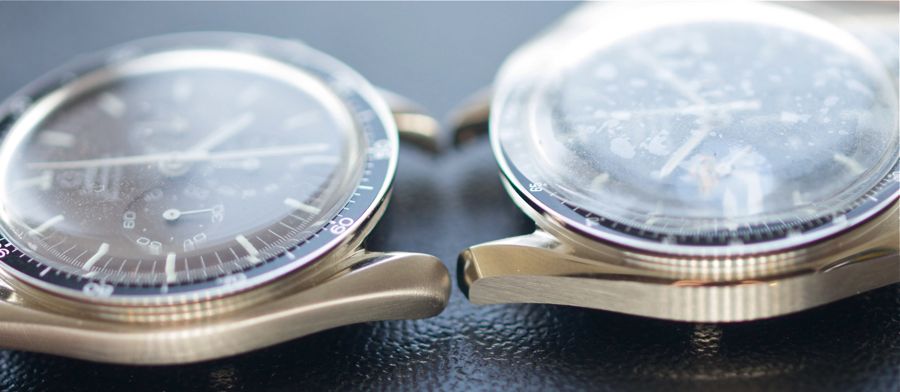

Water Damage:
105.012-66 Poor dial. Although the case and movement were perfectly fine.
The dial was so poor, that it was impossible to use it.

More Water Damage:
A water damaged 861 movement. The dial was fused to the movement and there was nothing I could do. The dial and movement were scrap.
That said I have successfuly rescued movements that looked worse than this.
Originality
This is the assessment of which parts are original to the watch, what has been replaced and if those parts are service, or original specification, or incorrect. Some times parts are replaced with original specification, but not strictly original to that particular watch. Sometimes we see service parts and sometimes parts are replaced by non omega parts.
Here is an example of a watch with non original service parts. An experienced collector will immediately see this watch as a serviced watch with replaced hands, dial, bezel and crown. As a result its desirability and value are greatly reduced.
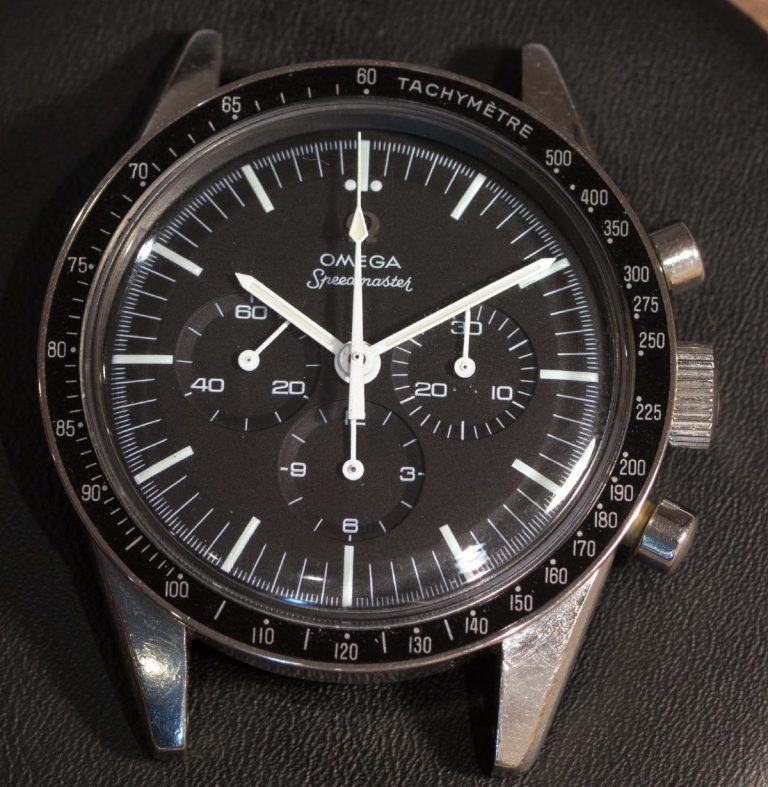
Originality
Using the following pages, you can establish the likelihood of the watch being original, or at least looking original. There is a difference between an original watch, and a watch that carries original specification parts. We are talking probabilities, as we cannot be sure if a watch has the actual same equipment as when it left the factory.What I look for is a watch with the correct equipment, that looks as though it has all experienced the same aging, and each part looks as though it is as aged as the next.
Oral history is great, but owners often forget or don’t know about service history. I have seen 2998’s with superluminova hands where the owners swear it has never been serviced. People are not necessarily dishonest, but manage to tell themselves a story so many times they believe it. Trust no one.
My goal is to have a watch that looks as original as possible.
If a watch has new dial and hands, or a new case it is not interesting. Omega supply an asymmetric service case for 321’s called a 145.0012. I have seen more than one watch built up into one of these cases. Very often these are without value to a collector who appreciates an original, attractively aged watch.
Box and Papers can be a red herring and, many times, are a married set – ie not original. The condition and originality is much more important then the presence of B&P’s. If a document has a serial on it then that’s interesting, and does add a little value. However when choosing between two watches, I will always choose the better condition over the paperwork. If I am offered a NOS watch and it doesn’t have B&P’s, then I wonder how it was completely unused and yet lost those? My advice is do not put too much store in B&P’s. Buy the watch, not the papers. If a very good watch has B&P’s I will pay more for it than without.
We must go through the watch under consideration carefully checking that each part is original specification, undamaged and in good condition. In order of importance by value are:
- The Dial
- The Case
- The movement
- The bezel
- The hands
Note: In the 861 references the dial value is less than the case, however I still base my decision primarily on the dial, then consider the case.
In the older references the cases are almost always polished, or worn. (You can always tell a Rolex Refugee coming to Speedmasters as he will ask the meaningless question, “Is it Polished?).
The dials can fade, and this fade can either add value or reduce it depending if it is attractive or not. The condition of the lume is also crucial to the value, and we must ascertain the lume is original, or stabilized or even replaced. The best re lume artists are so good that it is very hard to tell.
Hands are often replaced with service hands, and sometimes incorrect ones. The lume on hands is often replaced and often the original hands have been re painted. If it is done perfectly, it is very hard to tell, and in the case of hands, it can make little difference to the value.
Crystals are often replaced. They are a service item and often cracked or hazed, making it no sense to retain on the watch. Many keep the old crystal with the watch if they replace it, as the early old crystals can have different profiles and Omega logo.If the watch is completely untouched, I have seen collectors keep a damaged crystal on the watch, because absolutely nothing else has been changed. This really only happens on very valuable early, watches that will not actually be worn.
Crowns and pushers are also service parts so often replaced with service or incorrect ones. Older Crowns and pushers have a slightly different spec to the modern service items and people prefer the older originals, even if they are slightly damaged. In later references the differences are minimal.
Things that will stop me buying a watch are a deeply damaged case, either by corrosion or trauma, and a damaged or refinished dial.
The one thing that I will buy a watch for, even if everything else is wrong, is the dial. If the dial is nice, I want it. The dial is the heart of the value. A flawless 2998 dial is worth $6,000 to $10,000, or even more.
Here we can see Patina vs Condition:
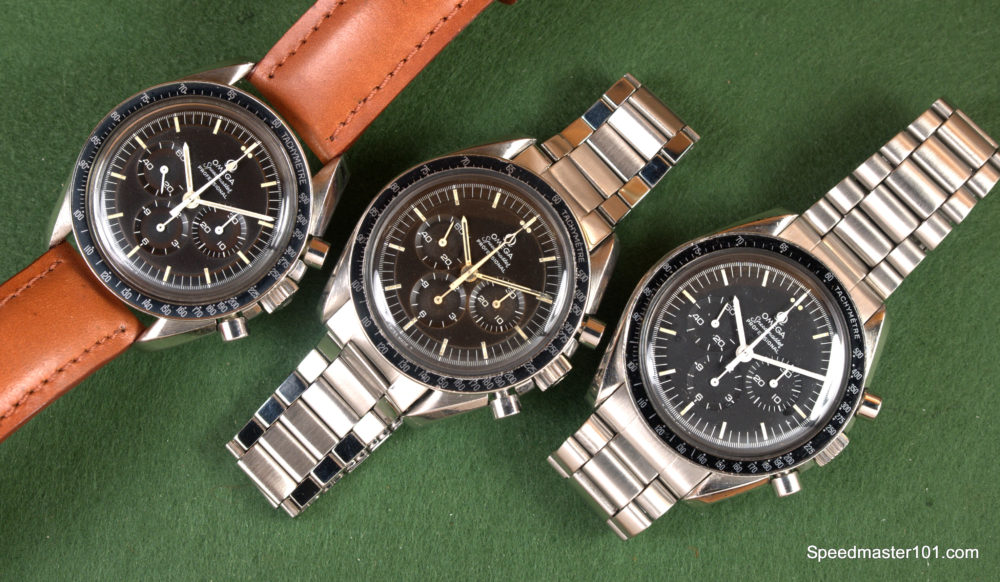
Three 145.022’s. The first two exhibit a pleasing patina, while the one on the far right is in close to factory fresh appearance with its black dial and clean hands
The above photo shows three identical references, with the exception of the production date. The far right hand watch has a dial and handset the same colour as when they left the factory. On the left, the two dials have degraded to a pleasing brown colour, and the hands have also changed. This kind of degredation is valued. The watch in the centre cost more than the two either side combined.
Which brings me to another important point. It is quite possible to pick up a pleasingly degraded watch for less than a good condition one. The value only appears once WE, the buyers, value it. Sometimes a degraded watch gets into the hands of an Italian or French dealer, where they give it a kiss of approval and off it goes into a rich collectors pocket for $20,000+.

You must be logged in to post a comment.